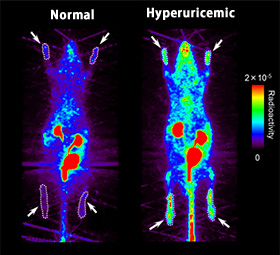
Uric acid is a biological molecule involved in many lifestyle-related diseases including gout, hypertension, renal diseases, and cardiac diseases. The majority of it is excreted in urine, but some remains in the blood. Increased blood concentration of uric acid and crystallization of uric acid within joints leads to hyperuricemia and gout, respectively. Determining where and at what concentration uric acid accumulates in the body may lead to early detection of urate-related diseases. To date, however, visualization of the accumulation and/or concentration of uric acid has not been realized using any imaging techniques.
The Molecular Probe Dynamics Laboratory, RIKEN Center for Molecular Imaging Science and other teams employed positron emission tomography (PET), a nuclear medical imaging modality, in order to determine the accumulation and concentration of uric acid within the body in an accurate and quantitative manner. A carbon radioisotope, 11C, was incorporated into uric acid in order to synthesize [11C]uric acid that was then used as a PET probe (an agent with an incorporated positron-emitting radioisotope), and experiments were carried out in rats.
[11C]uric acid was intravenously injected into normal rats as well as hyperuricemic rats. After the PET analysis of its flow through the rats' bodies, they succeeded in obtaining a series of images of the circulating injected [11C]uric acid and also its excretion in the urine. They also found that the accumulation of uric acid was 2.6 fold higher in the upper and lower limb joints of the hyperuricemic rats compared with that in normal rats. This technique, if applied in clinical PET screening with [11C]uric acid used as an imaging diagnostic agent, may be a promising tool for realizing the early diagnosis of urate-related diseases such as gout.
*This study was carried out under the joint research of RIKEN Center for Molecular Imaging Science (CMIS) (Yasuyoshi Watanabe, Director), and Department of Pharmacokinetics and Non-Clinical Safety, Kobe Pharma Research Institute, Nippon Boehringer Ingelheim Co. Ltd., and Department of Membrane Transport and Biopharmaceutics, Faculty of Pharmacy, Institute of Medical, Pharmaceutical and Health Sciences, Kanazawa University.
*These study results have been published in Bioorganic & Medicinal Chemistry Letters (2012, Volume 22, Issue 1, Pages 115-119, DOI No.: 10.1016/j.bmcl.2011.11.055).
 |
Fig 1. Radiosynthesis of [11C]uric acid.
|
 |
Fig 2. Representative whole body PET image in rats |
